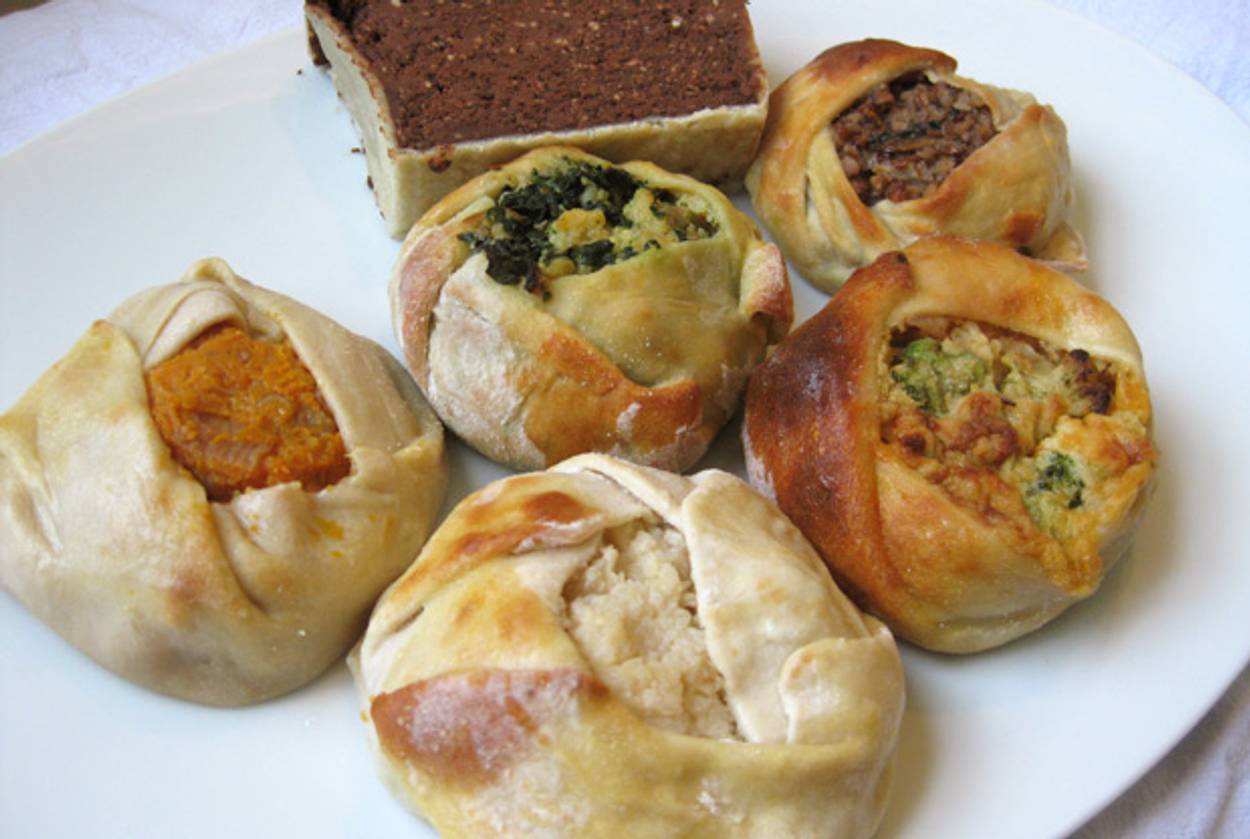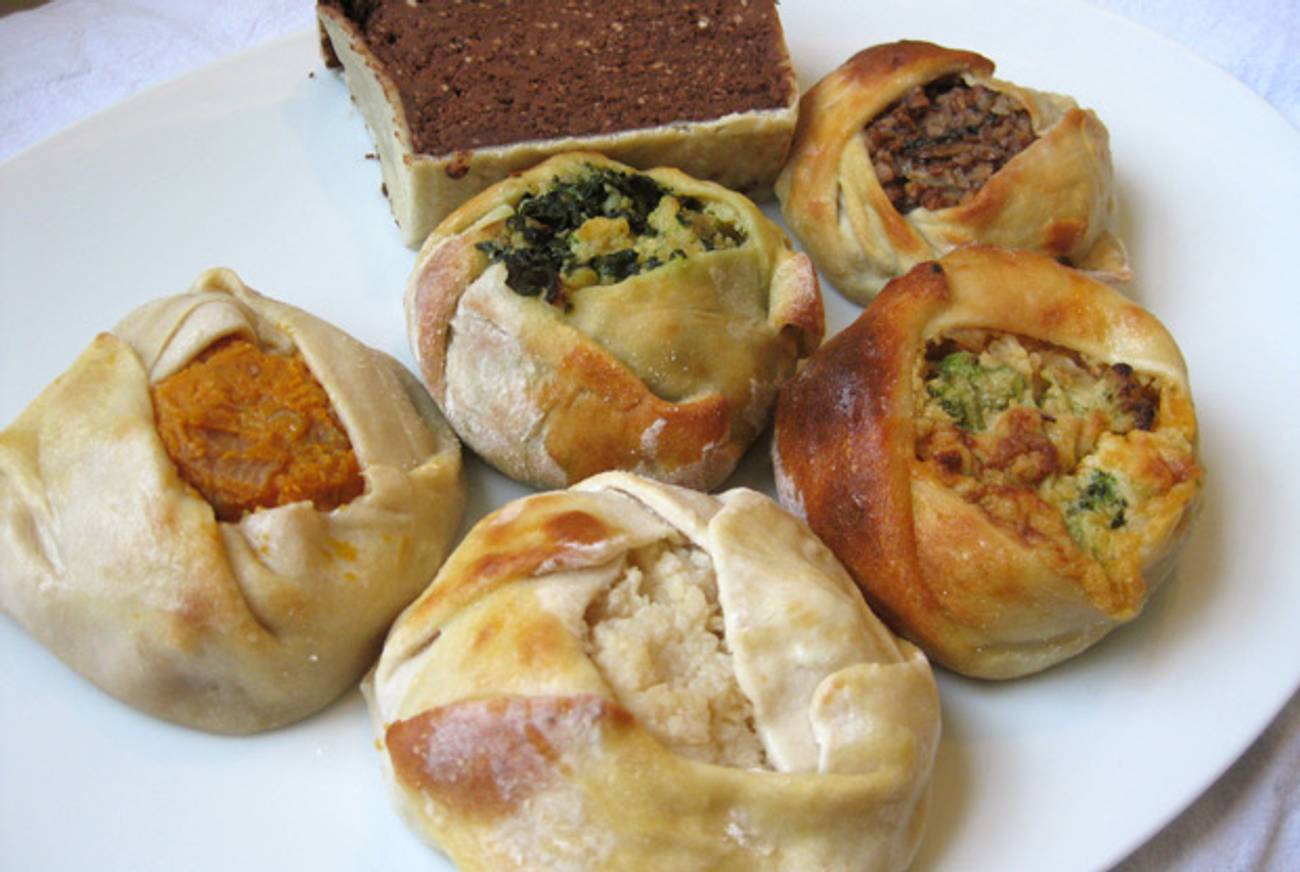Dough Boy
After stints working in graphic design and pizza-making, Noah Wildman found his true culinary calling in making a better knish




When I was 13 and my father deemed me ready for the kind of education only to be found within the bloated knishes of Brighton Beach, we drove from New Jersey to Brooklyn for the day so he could introduce me to his beloved Mrs. Stahl’s, the crème de la crème of the knish world, nearly a decade before it closed its doors for good in the fall of 2005.
The knishes there came hot, right off the warming block, and we took them to eat on the go. I savored my potato spinach knish, blowing on it before each bite rather than waiting for it to cool down, too eager to eat the dense, moist yet flaky-crusted dumpling as we wandered under the train tracks to the Coney Island freak shows nearby. Though Mrs. Stahl’s demise didn’t mean the end of the knish in New York City, it did mean, for many of the food’s devotees, the end of a knish worth traveling for.
But the arrival of a new knish maker in town might be cause to reconsider the lament that the golden days of the knish are over. This fall a quixotic 40-year-old Lower East Sider named Noah Wildman launched Knishery NYC, with the hopes of restoring the food’s glory. “The knish chose me,” Wildman told me. He has begun delivering knishes to customers in New York City by bicycle, and his pushcart start-up will soon be vending at street fairs around the city this coming spring. (An early snowfall in late October scuttled Wildman’s plans to debut seven types of his knishes at the annual Hester Street Fair.)
The revisiting of so simple a food as the knish—a doughy shell usually stuffed with potato, kasha, or cheese—has been a long time coming. Great knishes can be elusive, while adequate and sometimes disappointing ones, like those available at Yonah Schimmel in Manhattan and Knish Nosh in Queens, generally prevail.
Wildman has no plans to remake the knish, a staple of the working class, into haute cuisine. “Part of Jewish character is to see through the silliness,” he said. “To go for substance.” And few Jewish foods are as packed with substance as the knish. The baked dumpling came to the United States at the end of the 19th century by way of Eastern Europe, with competing accounts tracing the pastry’s origin to either the Polish town of Knyszyn or to a village in Slovakia. The knish fillings offered a terrific way to add variety to a monotonous diet heavy on potatoes, cabbage, and buckwheat. There were also knish varieties tied to the Jewish holidays, according to Joan Nathan, such as kasha for Hannukah and chicken liver for Rosh Hashanah.
At the turn of the 20th century, Jewish immigrants in the United States would bring knishes—a portable and filling pocket food—to lunch with them at their factory jobs. As the food writer Arthur Schwartz notes in Jewish Home Cooking, knishes, which were cheap, were also popular fare, often paired with hotdogs, at the beaches around New York City. Back then, Manhattan’s famous Second Avenue, home to the Yiddish theater, was known as Knish Alley. In 1910, Yonah Schimmel opened a knish store on Houston Street on Manhattan’s Lower East Side. Six years later, the New York Times reported on a “knish war,” when rival bakeries on Rivington Street slashed prices and introduced cabaret sideshows to attract customers.
Now a new generation of Jewish chefs and bakers around the country are making their claim on such classic dishes. Kenny and Zuke’s, in Portland, Ore., offers a potato-and-onion variety with layers of flaky dough, topped with caramelized onions. Wise Sons Jewish Delicatessen, in San Francisco, has its own occasional potato-onion knish iteration, with the onions cooked down in schmaltz; the deli also offers potato with mushroom and kale, and potato with cubes of house-cured corned beef. “People go crazy for them,” Leo Beckerman, one of Wise Sons’ proprietors, said.
And then there’s Wildman. Raised in a Reform household on Staten Island, Wildman, who now lives just blocks away from Rivington Street on the Lower East Side, grew up eating frozen knishes but never imagined that he would one day be baking them. He had studied sociology at SUNY Albany but ended up working in the recording industry as the manager of a record label, after which his efforts publishing the zine The People’s Ska Annual led him to a job as a graphic designer for MTV. When he was laid off in 2008, Wildman enrolled in culinary school. After a few years making pizza at the much-loved Franny’s and Amorina in Brooklyn, and then working at Ignazio’s also in Brooklyn, he left last summer to pursue a project of his own.
A series of serendipitous encounters led him to the knish. Wildman visited Williamsburg’s weekly food festival, Smorgasburg, and was inspired by the new approaches to classic ethnic fare that he found there. Danny Macaroon, for example, had breathed new life into the coconut pastry associated with Passover, and various kimchi makers had successfully re-branded the Korean fermented vegetable staple for the average New Yorker. At the same time, Wildman stumbled into a well-timed lecture series on the knish taught by one of food’s greatest contemporary champions, Laura Silver, a writer in New York City.
Reawakened by Silver’s enthusiasm, Wildman tried out four different recipes to find a dough that balanced crisp and elastic textures with chewy and crumbly consistencies. “The dough is a vehicle for filling, but you need the vehicle first,” he said. He uses two kinds of dough—one for savory knishes and one for sweet ones, “a kind of Bubbe’s pâte sucrée.” Keeping the right proportion of dough to filling is one of the most critical elements of a perfect knish, Wildman said. His fillings range from high-quality versions of the standards to savory pumpkin, apple-cheese, and chocolate hazelnut. In addition, he plans future fillings of curry sweet potato, the crispy chicken fat known as gribenes, and mushroom-quinoa.
The Knishery NYC is in its infancy, but Wildman is already producing knishes to reckon with, with a sensible dough-to-filling ratio, and in sizes more baseball than softball. Served with a Lime Rickey and deli mustard, Wildman’s knishes could be a spiritual experience, or at least one that brings back the memory of Mrs. Stahl.
Jeffrey Yoskowitz is a freelance writer in New York and the editor of the website Pork Memoirs.
Jeffrey Yoskowitz is a freelance writer in New York and the editor of the website Pork Memoirs.